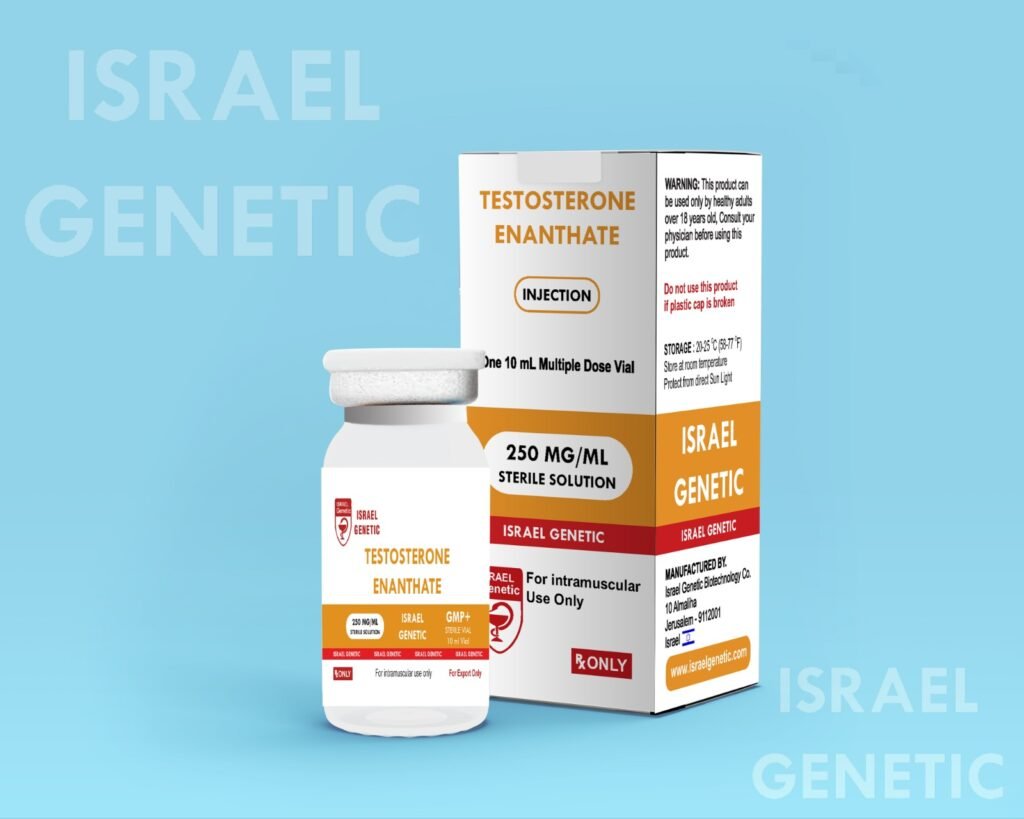
Testosterone Enanthate in a clear colourless to pale yellow sterile liquid for intramuscular injections.
Each ml contains Testosterone Enanthate 250 mg. Testosterone Enanthate is insoluble in water: nearly soluble in alcohol, chloroform. dioxane, and in ether; soluble in vegetable oils.
Testosterone esters in oil injected intramuscularly are absorbed slowly from the lipid phase; thus, Testosterone Enanthate can be given at intervals of two to four weeks.
Testosterone in plasma is bound for 98% to a specific testosterone-estradiol binding globulin. Generally, the amount of this sex-hormone binding globulin in the plasma will determine the distribution of testosterone between free and bound forms and the free testosterone concentration will influence its half-life. About 90 percent of a dose is excreted in the urine as glucuronic and sulphuric acid conjugates of testosterone and its metabolites; about 6 percent of a dose is excreted in the feces, mostly in the unconjugated form. Inactivation of testosterone occurs primarily in the liver. Testosterone is metabolized to various 17-keto steroids through two different pathways. The half-life of Testosterone Enanthate when injected intramuscularly is. approximately eight days.
Activity of testosterone appears to depend on reduction to dihydrotestosterone, which binds to cytosol receptor proteins. The steroid-receptor complex is transported to the nucleus where it initiates transcription events and cellular changes related to androgen action.
Testosterone Enanthate is indicated for replacement therapy in the male in conditions associated with symptoms of deficiency or absence of endogenous testosterone. Primary hypogonadism (congenital or acquired)-testicu1ar failure due to cryptorchidism, bilateral torsion, orchitis, vanishing testis syndrome; or orchidectomy. O Hypogonadotropic hypogonadism (congenital or acquired) idiopathic gonadotropin or LHRH deficiency, or pituitary-hypothalamic injury from tumors, trauma, or radiation.
Testosterone Enanthate is for intramuscular use only. It should not be given intravenously. Intramuscular injections should be given deep in the gluteal muscle. The suggested dosage for Testosterone Enanthate varies depending on the age, sex, and diagnosis of the individual patient. Dosage is adjusted according to the patient’s response and adverse reactions. Various dosage regimens are used to induce pubertal changes in hypogonadal males; some experts have advocated lower dosages initially, gradually increasing the dose as puberty progresses, with or without decrease to maintenance levels. Other experts emphasize that higher dosages are needed to induce pubertal changes and lower dosages can be used for maintenance after puberty. The chronological and skeletal ages must be taken into consideration, both in determining the initial dose and in adjusting the dose. For replacement in the hypogonadal male, 50-400 mg should be administered every two to four weeks. Parenteral drug products should be inspected visually for particulate matter and discoloration prior to administration, whenever solution and container permit. Warming and shaking the vial should dissolve any crystals that may have formed during storage at temperatures lower than recommended.
Androgens may increase sensitivity to oral anticoagulants.
Dosage of the anticoagulant may require reduction in order to maintain satisfactory therapeutic hypoprothrombinemia. Concurrent administration of oxyphenbutazone and androgens may result in elevated serum levels of oxyphenbutazone. In diabetic patients, the metabolic effects of androgens may decrease blood glucose and, therefore, insulin requirements. Testosterone Enanthate is not recommended for use in nursing mothers.Warnings and precautions.
Hypercalcemia may occur in immobilized patients. If this occurs, the drug should be discontinued. Prolonged use of high doses of androgens (principally the 17-a alkyl-androgens) has been associated with development of hepatic adenomas, hepatocellular carcinoma, and peliosis hepatis, which all potentially life-threatening complications. Geriatric patients treated with androgens may be at an increased risk of developing prostatic hypertrophy and prostatic carcinoma although conclusive evidence to support this concept is lacking.
Edema, with or without congestive heart failure, is a serious complication in patients with pro-existing cardiac, renal or hepatic disease. Gynecomastia may develop and persist in patients being treated for hypogonadism. This product contains benzyl alcohol. Benzyl alcohol has been reported to be associated with a fatal “gasping syndrome“in premature infants. Androgen therapy should be used cautiously in healthy males with delayed puberty. The effect on bone maturation should be monitored by assessing bone age of the wrist and hand every 6 months. In children, androgen treatment may accelerate bone maturation without producing compensatory gain in linear growth. This adverse effect may result in compromised adult stature. The younger the child is the greater the risk of compromising final mature height might be.
Patients with benign prostatic hypertrophy may develop acute urethral obstruction.
Priapism or excessive sexual stimulation may develop. Oligospermia may occur alter prolonged administration or excessive dosage. If any of these effects appear, the androgen should be stopped and if restarted, a reduced dosage should be utilized. Testosterone Enanthate should not be used interchangeably with Testosterone propionate because of differences in duration of action.
– Known hypersensitivity to the drug
– Males with carcinoma of the breast
– Males with known or suspected carcinoma of the prostate gland – Women who are or who may become pregnant
– Patients with serious cardiac, hepatic or renal disease
The following adverse reactions in the male have occurred with some androgens:
Endocrine and urogenital: gynecomastia and excessive frequency and duration of penile erections.
Oligospermia may occur at high dosages. Skin and appendages: hirsutism, male pattern of baldness, seborrhea, and acne. Fluid and electrolyte disturbances: Retention of sodium, chloride, water, potassium, calcium, and inorganic phosphates. Gastrointestinal: Nausea, cholestatic jaundice, alterations in liver function tests, rarely hepatocellular neoplasms and peliosis hepatis. Hematologic: Suppression of clotting factors II, V, VII, and X, bleeding in patients on concomitant anticoagulant therapy, and polycythemia. Nervous system: Increased or decreased libido, headache, anxiety, depression, and generalized paresthesia.
Allergic: Hypersensitivity, including skin manifestations and anaphylactic reactions.
Miscellaneous: Inflammation and pain at the site of intramuscular injection.
Store in a dark, dry place. Keep away from children.
1x10ml glass vial
Copyright © ISRAEL GENETIC 2020 | All Rights Reserved